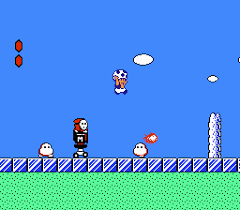
Genre: Platform
Year: 1988
Developed by: Nintendo R&D 4
Published by: Nintendo
Platforms: NES, Super NES, Game Boy Advance
#201
Feeling Like: Atypical sequel
Every review, retrospective and analysis of Super Mario Bros. 2 mentions how strange it is and I can’t argue. The original had a few quirks, but this was a total departure from reality. Goombas, Koopas and Bowser are nowhere to be found. You don’t just walk to the right, as stages are vertical and subterranean. You can choose four different characters, each with their own unique ability. Secrets are different, collectibles provide different kind of bonuses; there’s barely any consistency from its predecessor. Even the fundamental mechanic of jumping on enemies to kill them isn’t here – you just hitch a ride if you jump on top of them.
What the hell?
Nintendo certainly wasn’t afraid to try different things when it came to NES sequels (Zelda 2: The Adventure of Link is as big, if not bigger, a departure from The Legend of Zelda). It was one of my favorites on the NES for how bizarre it was, how much fun it was to throw items at enemies, dodging the Phanto when picking up a key and floating as the Princess. Everybody picked the Princess or Toad, right? Mario and Luigi already got their due in Super Mario Bros. anyway.

I really couldn’t get enough. Even though it was a drastic departure, it still felt like a Mario game…just a Mario game in a weird, dream-like world. A completely new adventure. And considering how little attention nowadays is paid to it, Super Mario Bros. 2 sure was responsible for many Mario mainstays; Birdo, Bob-Ombs, and the Shy Guys had their debut appearances here. For the first time, you could play characters outside of the plumber brothers. Levels would sometimes have you going to the left. Some areas you had to dig your way to freedom. Ducking for a few moments enabled you to do a high jump. Cherries!
To me, it was more replayable since I’d often run through the game entirely as Toad (my boy), then as Luigi, etc. Since Mario was a jack of all trades and the Princess could float, levels presented different challenges depending on who you played. Secret potion areas encouraged experimentation to find the best goodies. Times could always be improved upon.

Because the strategy changed from jumping on enemies to finding the nearest thing you could pull from the ground and throw it at them, the mindset was altered. I was looking for leafy tops of weeds as much as the enemies themselves, then had to decide where to spend my ammunition. Oftentimes it was easy to just bypass danger, but I didn’t always have that luxury. It was less about dodging the chasms of doom, but more about how to get across them.
Maybe it’s not all that different from Super Mario Bros. after all.
Or it was that I was a few years older when I played it. I had a Nintendo Entertainment System of my own and I felt far more comfortable trying things out. I don’t know if this is the game in the series that counts as the black sheep, it could be Super Mario Sunshine but it could also be the dozen of poor spin-offs that teach you typing or history or something equally education and unfun.

I’m having a hard time putting into words why this odd little title triumphs over one of the most influential, important games of my life, but I suppose in the end it was different enough to capture my attention, challenging enough to keep me hooked and replayable enough to ensure I got way more hours on it than the original.
Previous 202 Super Mario Bros.